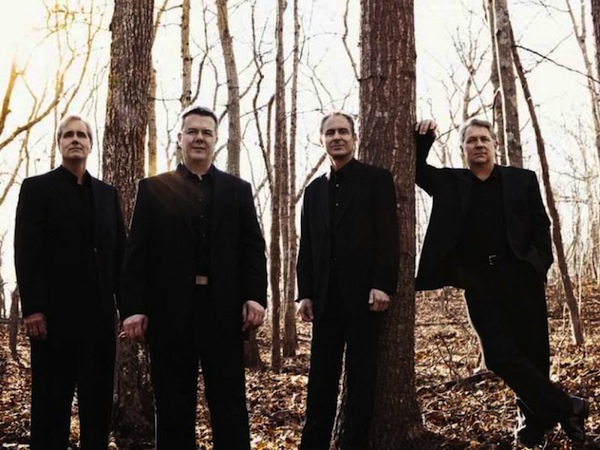Renovated Terrace Theater makes mixed sonic impression with chamber music

The Emerson String Quartet performed in the Kennedy Center’s reopened Terrace Theater Thursday night. Photo: Lisa-Marie Mazzucco
The Kennedy Center closed its chamber music venue, the Terrace Theater, over a year ago for what it called a renovation. The space has reopened this month, and a series of inaugural concerts included a concert of chamber music by ensembles of various sizes. Presented by the Fortas Chamber Music Concerts series, this event revealed that the Terrace Theater underwent not so much a renovation as a complete repurposing.
According to President Deborah Rutter, the Kennedy Center wanted the venue to become a “highly versatile space,” which will host the growing jazz, pop, and hip hop offerings Rutter seeks to expand.
To that end, a major update of the “stage configurations and audio-visual systems” was a large part of the $21 million work. Tellingly, the first concert in the hall featured jazz and hip hop musicians Jason Moran and Q-Tip.
Trumpeters Brandon Eubank and Amy McCabe opened the evening with Johann Verdanck’s Capriccio a due Cornetti, a three-minute fanfare for twin instruments from the 17th century. The musicians stood at the theater entrances, which are now placed in the corners of the theater, leading into newly created balconies, rather than at the back of the hall. The antiphonal effect of the duo’s clean, shining sound was pronounced, ringing off the sides of the now widened hall.
The two trumpeters then moved down to the stage for the much shorter Fanfare for a New Theater by Stravinsky, a reversal of the order of these pieces in the printed program. This was an odd choice, since the piece, written for the opening of Lincoln Center’s New York State Theater, called for the two trumpets to play from either side of the balcony, at that hall’s entrance. The interplay of pointy, often dissonant motifs bounced around the space crisply.
Fortas artistic director Joseph Kalichstein next took the stage, with guest pianist Lisa Emenheiser, to play four of Dvořák’s Slavonic Dances, in the original four-hands version. As with the trumpet pieces, the Steinway, played with crashing force by Kalichstein, revealed that the renovation has stripped away much of the former warmth of the acoustic. The acoustic is drier now, creating a more direct sound that will likely favor amplified performance.
The renovation has opened up the hall, to create small balconies on both sides, part of the trend towards “skyboxification” in sports and other venues. The number of seats has decreased, from 512 to 485, but with a much-needed increase in ADA-mandated accessible seating. The angle of the seating seems less raked, making the stage seem more distant. At the same time the stage, which has not been altered in size, has been opened up with a moveable proscenium arch, so that the venue seems less intimate.
Three major chamber music works rounded out a long program, running three hours with two intermissions. Members of the Dover Quartet joined Kalichstein for Brahms’ Piano Quartet in G minor. Violinist Joel Link broke a string in the middle of the first movement, which was frenetic even without the broken string. The second movement was stronger, taken at a relaxed tempo and with gorgeous sections for the string players alone. The bright edge of the new acoustic did no favors for the strident rendition of the third movement, although the gutsy brashness of the finale brought the piece to a rousing conclusion.
Two larger string pieces made a more favorable impression in the room. The sextet version of Schoenberg’s Verklärte Nacht opened at and undulating pace, with supremely rich viola solos from the Emerson Quartet’s Lawrence Dutton. The immediacy of the room made the softer dynamics dull but sharpened the fuller ones, although it also lay bare things that might be covered in a more generous room, like the occasional struggles of violinist Eugene Drucker at the high end of the first violin part.
The two string quartets then came together for the largest piece of the night, Mendelssohn’s legendary Octet for Strings, heard from the forward section of one of the balconies. The Terrace Theater looks much like the Kennedy Center Family Theater now, full of curving acoustic wood panels, and the sound tended to be more individualized than blended, so that as heard on the side, the Emerson String Quartet players, facing toward us, were more present than the Dover Quartet, facing away.
Balances sometimes seemed off here as well, with the bass sound occasionally overpowering in the first movement. The second movement was lovely, with the tender suspensions of the melting theme. In the third movement, all was impressively fast, well ordered and coordinated but without much time to shape anything. The too rapid Scherzo meant that the dizzying pace of the Presto finale did not sound much faster, but the two quartets made a dazzling display in this chamber music showpiece.
____________
Mason Bates will be staying in Washington a little longer. The Kennedy Center announced this week that it will extend his contract as Composer in Residence for two additional seasons, through the 2019–2020 season.
During his tenure the 40-year-old composer, raised in Richmond, Virginia, established an unusual concert series at the Kennedy Center called KC Jukebox. These concerts aim to attract a non-classical audience to the Kennedy Center, bringing together music by contemporary composers from a range of genres.
Since Bates’s appointment at the start of the 2015–2016 season, the National Symphony Orchestra has also performed several of his symphonic works.


